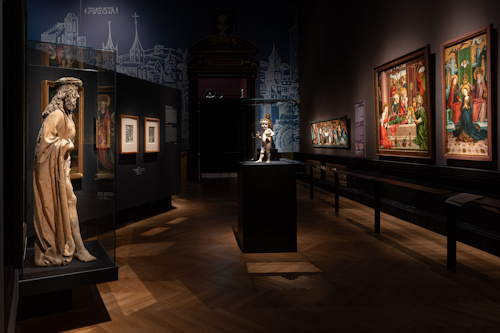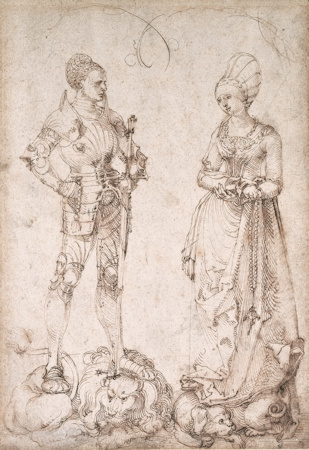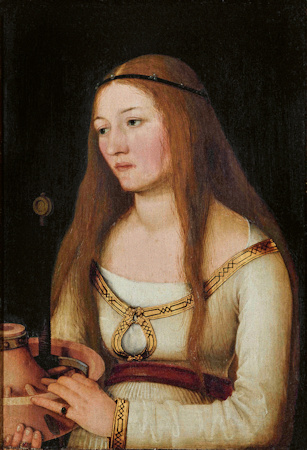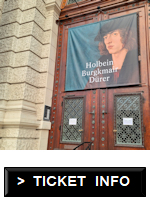In the early 1500s, the free city of Augsburg stood at the centre of an artistic (r)evolution inspired by Italy and the Netherlands. A Kunsthistorisches Museum exhibition presents the great pioneers of this Renaissance in the north.
- Focus on Holbein (the elder) & Burgkmair
- Over 160 works
- …paintings, drawings, prints etc.
- Includes many prestigious international loans
- And works by other artists
- …such as Holbein (the younger)
- Runs Mar 19 – Jun 30, 2024
- Book your KHM tickets* online
- See also:
Renaissance in the North

(Hans Burgkmair the Elder, Portrait of a Young Man, 1506, poplar panel, 41.1 x 28 cm, Vienna, Kunsthistorisches Museum, picture Gallery; press photo © KHM-Museumsverband)
Ah, the early days of the Renaissance. Imagine golden sunlight, an inspired young painter and a view across the Lech river as it growls its way up through Augsburg to the mighty Danube a little north of Munich.
Hang on.
Surely we mean the Arno river in Florence or the Adriatic Sea?
Ah…Italy may have birthed the Renaissance but others followed, of course. And pioneering artists in Augsburg and Nuremberg, in particular, led the transition on the chillier side of the Alps.
The Holbein. Burgkmair. Dürer exhibition focuses on the prominent names behind this Renaissance in the north.
This means primarily the Augsburg painters Hans Holbein the Elder (c.1464-1524) and Hans Burgkmair the Elder (1473-1531). Though Nuremberg’s Albrecht Dürer (1471-1528), as the exhibition title suggests, also gets special mention, particularly through his own commissions in Augsburg.

(View of the exhibition; press photo © KHM-Museumsverband)
Other artists of the time also feature, the most notable being Hans Holbein the Younger (c.1497-1543). He took things to another level, as is immediately apparent when viewing the works side-by-side.
Paintings, drawings, prints, sculptures and more illustrate the evolutionary artistic journey taken with the help of our prominent painters and their colleagues. The works come from numerous prestigious sources, including the likes of New York’s Metropolitan Museum and Berlin’s Staatliche Museen.
The exhibition itself is a cooperation between the Kunsthistorisches Museum and Frankfurt’s Städel Museum.
Emperors and Fuggers
Augsburg’s key role in Renaissance art came about in part through its prominent political and economic status at the time.
The “great” and “good” of the Holy Roman Empire often met in the city; Maximilian I, the Habsburg Holy Roman Emperor visited many times. And the Fugger banking family pulled the strings of the European economy from Augsburg.

(Albrecht Dürer, Design for the tomb of Jakob and Sibylla Fugger, c.1510, Pen and ink drawing, Oxford, Christ Church Picture Gallery, Inv. 1109; press photo © Christ Church Picture Gallery)
Indeed, you might argue that the Fuggers actually set everything in motion with their commissions for portraits and other works.
The exhibition includes, for example, Dürer’s c.1510 pen & ink designs for the tombs of Jakob and Sibylla Fugger as well as for the tomb of Jakob’s brother, Ulrich.
Trade and travel certainly brought wealth, knowledge and influence to Augsburg.
Burgkmair drew on experiences gained in Northern Italy, for example. Holbein the Elder stayed truer to the impressions gathered from the Netherlands, where he may also have spent time in his early years.
The exhibition displays take both an artistic and historical perspective.
So we get to see how the scope and skill of the titular artists change with time and how external influences flowed into their work. But we also get insights into Augsburg life, society, the art market, the art community and the crucial shift from artist as craftsperson to artist as artist.

(Hans Holbein the Elder, St Catherine (possible portrait of Katharina Schwarz), c.1509/10, maple panel, 39.5 x 28.4 cm; press photo © Stiftung Schloss Friedenstein Gotha, Inv. SG 692)
It all feels like a window into an era. And for an even deeper dive into the art and era, a side room has comfortable sofas, ambient music, and interactive tablets with a huge amount of additional detail.
Some of the art demonstrates a remarkable versatility. No job too small. No medium too new. Particularly in the oeuvre of Burgkmair, who seems notably innovative and a man who clearly invested a lot of time into his art.
And alongside the portraits, woodcuts, putti and other pieces of art, some unexpected delights.
For example, Burgkmair and his wife Anna appear in a 1529 portrait by Lucas Furtenagel. Our famed painter wears a gold signet ring in the painting. And that almost 500 year-old ring is on display next to it. Bravo!
Dates, tickets & tips
Experience the Renaissance in the North from March 19th to June 30th, 2024. An entrance ticket for or from the Kunsthistorisches Museum includes this special exhibition.
(Booking service provided by Tiqets.com*, who I am an affiliate of)
Needless to say, the Kunsthistorisches Museum is itself a treasure trove of Renaissance art in its wonderful picture galleries and Kunstkammer. For more along these lines, try the nearby Academy of Fine Arts too.
Vienna also has Dürer’s perhaps most famous work: the Young Hare. That, however, is not on public view at the moment.
How to get there
Follow the travel tips in the main museum article.
Address: Burgring 7, 1010 Vienna
